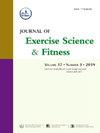Effects of variable resistance training with different load ratios on lower-limb strength and power in male college students
IF 2.4
2区 医学
Q2 SPORT SCIENCES
引用次数: 0
Abstract
Objective
The optimum relationship combination of variable to constant resistance within variable resistance training (VRT) for enhancing lower-limb strength and power remains unclear. This study aimed to investigate how different ratios of variable to constant resistance in VRT affect lower-limb strength and power.
Methods
Forty-five male college students (age: 21.65 ± 2.20 years; height: 179.65 ± 4.98 cm; body mass: 77.21 ± 6.77 kg; resistance training experience: 3.00 ± 0.96 years) were randomly assigned to three groups: 20 % VRT (n = 15), 35 % VRT (n = 15), and constant resistance training (CRT, n = 15). All groups trained squats twice weekly for 6 weeks at 80 % 1RM total load (20 % VRT: 20 % variable resistance combined 80 % constant resistance; 35 % VRT: 35 % variable resistance combined 65 % constant resistance; CRT: 100 % constant resistance). Pre- and post-experiment tests included squat 1RM, countermovement jump (CMJ), squat jump (SJ), standing broad jump (SBJ), 20-m sprint, and rectus femoris cross-sectional area (RFCSA). A mixed-design ANOVA (group × time) was used for data analysis.
Results
The 20 % VRT group surpassed CRT in maximal strength cross-sectionally (F = 3.565, p = 0.037) but not longitudinally (p = 0.079). All groups improved strength over time (p < 0.001; Cohen's d = 0.87–0.94). A significant interaction (F = 3.407, p = 0.043) indicated SJ improvement for 35 % VRT vs. CRT (p < 0.05, Cohen's d = 0.43), with no CMJ, SBJ, sprint, or RFCSA differences (p > 0.05).
Conclusion
VRT and CRT yield equivalent long-term strength gains. Different combinations of variable to constant resistance ratios in VRT (20 % and 35 %) led to distinct task-specific adaptations in lower-limb performance. Practitioners should prioritize 35 % VRT for static explosive tasks, use 20 % VRT as a supplementary strength tool.
不同负荷比的可变阻力训练对男大学生下肢力量和力量的影响
目的 在可变阻力训练(VRT)中,可变阻力与恒定阻力的最佳关系组合对增强下肢力量和功率的作用仍不明确。本研究旨在探讨可变阻力训练中可变阻力与恒定阻力的不同比例如何影响下肢力量和功率:3.00 ± 0.96 年)随机分配到三个组:20% 阻力训练组(15 人)、35% 阻力训练组(15 人)和恒定阻力训练组(15 人)。所有组别每周进行两次深蹲训练,为期 6 周,总负荷为 80 % 1RM (20 % VRT:20 % 可变阻力与 80 % 恒定阻力相结合;35 % VRT:35 % 可变阻力与 65 % 恒定阻力相结合;CRT:100 % 恒定阻力)。实验前后的测试包括深蹲 1RM、反身跳(CMJ)、深蹲跳(SJ)、立定跳远(SBJ)、20 米短跑和股直肌横截面积(RFCSA)。结果 20% VRT 组的最大力量横截面超过了 CRT 组(F = 3.565,p = 0.037),但纵截面没有超过 CRT 组(p = 0.079)。随着时间的推移,所有组的力量都有所提高(p < 0.001; Cohen's d = 0.87-0.94)。一个显着的交互作用(F = 3.407,p = 0.043)表明,35 % VRT 与 CRT 相比,SJ 有改善(p < 0.05,Cohen's d = 0.43),而 CMJ、SBJ、冲刺或 RFCSA 没有差异(p > 0.05)。在 VRT 中,可变阻力与恒定阻力比率的不同组合(20% 和 35%)会导致下肢表现出现不同的任务特异性适应。对于静态爆发力任务,练习者应优先选择 35% 的 VRT,将 20% 的 VRT 用作辅助力量工具。
本文章由计算机程序翻译,如有差异,请以英文原文为准。
求助全文
约1分钟内获得全文
求助全文
来源期刊
CiteScore
5.10
自引率
3.60%
发文量
54
审稿时长
31 days
期刊介绍:
The Journal of Exercise Science and Fitness is the official peer-reviewed journal of The Society of Chinese Scholars on Exercise Physiology and Fitness (SCSEPF), the Physical Fitness Association of Hong Kong, China (HKPFA), and the Hong Kong Association of Sports Medicine and Sports Science (HKASMSS). It is published twice a year, in June and December, by Elsevier.
The Journal accepts original investigations, comprehensive reviews, case studies and short communications on current topics in exercise science, physical fitness and physical education.

 求助内容:
求助内容: 应助结果提醒方式:
应助结果提醒方式:


